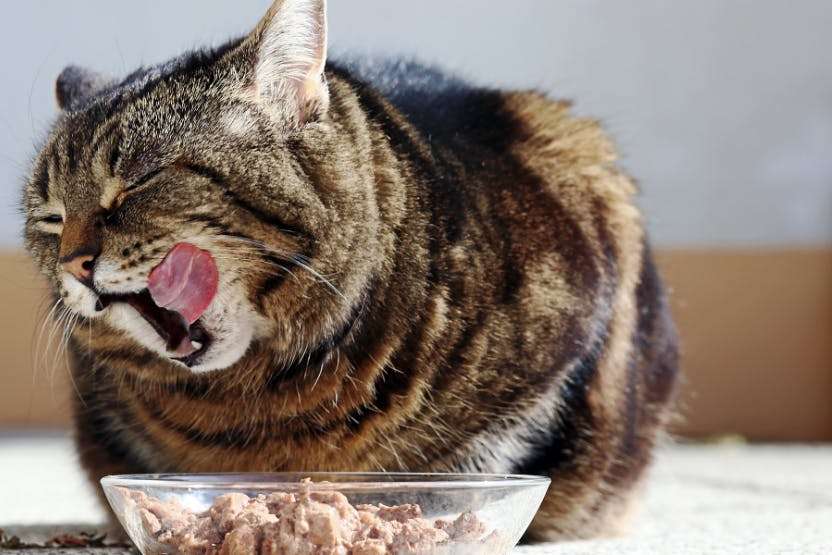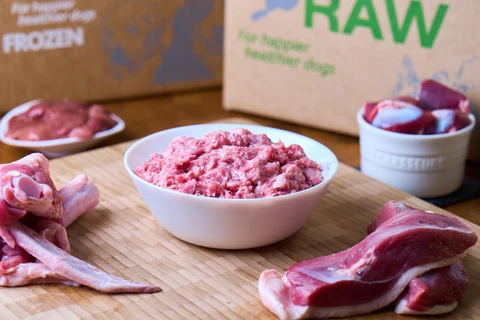Introduction
Raw feeding has become one of the most talked-about topics among pet owners in recent years. Many believe that a raw food diet for cats is closer to what their ancestors ate in the wild, mainly meat, bones, and organs, rather than heavily processed kibble. Supporters of this food claim it promotes healthier digestion, shinier coats, and better overall vitality.
On the other hand, veterinarians caution that feeding raw meat to cats carries risks, including nutritional imbalances and bacterial contamination. To help you make the best decision for your feline friend, this guide covers everything about raw cat foods, brands, raw treats for cats, and the pros and cons of a raw diet for cats.

What Is Raw Food for Cats?
A raw food diet typically includes:
- Raw muscle meat (chicken, turkey, rabbit, salmon, beef, etc.)
- Organ meats, such as liver, kidneys, and hearts (including raw chicken hearts), are often included.
- Edible bones (ground bones or meaty bones)
- Supplements (to balance missing nutrients)
Learn more about: Can dogs eat bell peppers
There are multiple methods that cat owners can use to provide a raw food diet to their pets.
- BARF (Biologically Appropriate Raw Food): focuses on raw meat, bones, and some vegetables.
- Prey Model Raw Diet: Designed to replicate a whole-prey meal, typically made up of about 80% muscle meat, 10% organs, and 10% edible bone.
- Commercial Raw Food Brands: Pre-made, balanced meals sold frozen or freeze-dried.
Some owners make homemade raw kitten food, while others choose raw wet cat food or commercial raw cat foods for convenience and safety.
Benefits of a Raw Food Diet for Cats
Advocates of the raw diet for cats often report significant improvements. Here are the most common benefits:
Species-Appropriate Nutrition
Being obligate carnivores, cats depend on protein from animal sources to meet their nutritional and energy needs. It provides essential amino acids like taurine, plus fatty acids and vitamins found in fresh meat.
Improved Digestion
Many cats digest unprocessed cat food or raw meals better than kibble. Owners often notice smaller, less odorous stools.
Healthy Skin & Coat
Raw diets rich in omega fatty acids support skin health and give cats a glossy, well-maintained coat.
Better Hydration
Unlike dry kibble, raw wet cat food is naturally high in moisture, which helps cats stay hydrated.
Weight Management
Choosing the best raw food for indoor cats may help control weight thanks to its high protein and low carbohydrate profile.
Risks of Raw Cat Food Diets
While the raw diet for cats has benefits, it also comes with challenges:
Bacterial Contamination
Raw meat may carry pathogens like Salmonella, E. coli, or Listeria, which can make cats or humans sick.
Nutritional Imbalances
Homemade raw meals without supplements may miss key nutrients such as taurine, calcium, or vitamin E.
Bone Risks
Whole bones can cause choking, broken teeth, or intestinal blockages. Ground bones or calcium supplements are safer.
Raw Fish Risks
Raw fish may contain thiaminase, which destroys vitamin B1, leading to neurological problems.
Human Health Concerns
Families with children, elderly people, or those with weak immune systems must handle raw cat foods carefully to avoid cross-contamination.
Popular Raw Cat Food Brands
Not all raw diets are homemade. Many cat owners prefer commercial raw cat food brands because they are tested for safety and often meet AAFCO standards. Some well-known options include:
- Rebel Raw Cat Food: A popular choice among raw feeders. Rebel Raw also offers Rebel Dog and Rebel Raw Dog Food, making it suitable for multi-pet households. Many Rebel Raw reviews praise its freshness and convenience.
- Nutriment & Purrform: UK-based raw cat food brands known for balanced formulations.
- Viva Raw: Offers frozen and pre-portioned meals for cats.
- Freeze-Dried Commercial Products: These pre-prepared raw cat foods are convenient, shelf-stable, and provide an easy way to include raw nutrition in your cat’s meals.
When choosing a brand, always check whether it is formulated as a complete and balanced raw cat food diet.
Raw Cat Food for Kittens
Kittens have higher nutritional needs for growth, so feeding raw kitten food requires extra care. They need the right balance of protein, fat, vitamins, and minerals to avoid growth issues.
Commercial raw kitten food is safer than homemade recipes since it is specifically designed to support development.
Safe Raw Feeding Practices
If you plan to feed raw meat for cats, follow these guidelines:
- Choose quality: Use human-grade meat or trusted raw cat food brands.
- Freeze first: Freezing raw meat for several days helps reduce parasite risks.
- Food Safety: Ensure hands, feeding bowls, and kitchen tools are cleaned thoroughly after handling raw food.
- Portion control: Adjust meals depending on whether your cat is active, senior, or one of the best raw food for indoor cats options.
- Supplements: Homemade diets may require taurine, vitamin E, calcium, and fish oil.
Alternatives to Raw Cat Food
Not all pet parents are comfortable feeding raw. Alternatives include:
- Lightly cooked diets: Still fresh, but safer.
- High-quality canned food: Similar moisture benefits as raw wet cat food.
- Commercial balanced diets: Cooked but nutrient-rich.
Can Dogs Have Applesauce?
While this article focuses on cats, many pet parents also wonder about dogs. Unlike raw diets, fruits like applesauce can sometimes be safe for dogs, but only plain, unsweetened varieties. Just as with salmon raw dog food or other specialty diets, always consult a veterinarian before adding new foods to your dog’s diet.
Expert Opinions on Raw Feeding
Most veterinarians remain cautious about raw food for cats due to risks of pathogens and deficiencies. Authorities such as the AVMA and CDC recommend avoiding raw feeding due to potential health risks.
However, holistic vets and many raw diet cat enthusiasts argue that, when done correctly, it can mimic the natural diet cats evolved on. Brands like Rebel Raw are often highlighted in Rebel Raw reviews as safer, balanced options compared to homemade versions.
FAQs About Raw Cat Food
Raw diets are more natural and higher in protein, but kibble is convenient, shelf-stable, and nutritionally complete.
Yes, but only if formulated correctly. Raw kitten food from trusted brands is the safest option.
Yes, chicken hearts raw are nutrient-rich and provide taurine, but they must be part of a balanced diet.
Commercial freeze-dried treats are safe, while homemade raw treats require careful preparation.
Look for low-calorie, high-protein commercial brands that balance nutrition without excess fat.
Conclusion
So, can cats have a raw food diet? Yes, but only when the diet is carefully planned, handled hygienically, and guided by a veterinarian or feline nutrition expert. While a raw food diet for cats can improve digestion, coat condition, and hydration, it also comes with potential risks such as bacterial contamination and nutrient deficiencies.
Choosing trusted raw food brands like Rebel Raw cat food or other reputable companies can make raw feeding safer. Alternatives like lightly cooked diets or high-quality canned foods also offer benefits without the risks of raw meat for cats.
Ultimately, whether you choose raw foods, raw treats for cats, or unprocessed cat food, always consult a veterinarian or feline nutritionist before making changes. That way, your cat can enjoy a diet that’s both safe and species-appropriate.


Pingback: Can Cats Eat Cheese? Safety, Risks & Better Treatment Options -
Pingback: Purina Cat Food: The Complete Guide to Nutrition
Pingback: Grain Free Dog Food – Benefits, Brands, and Nutritional Guide -